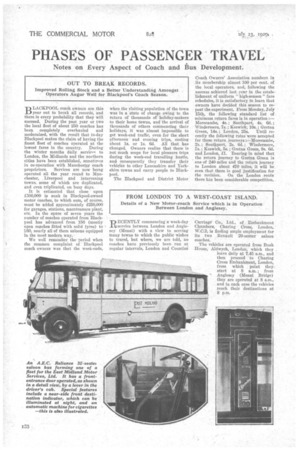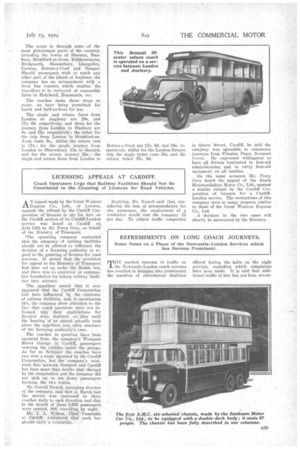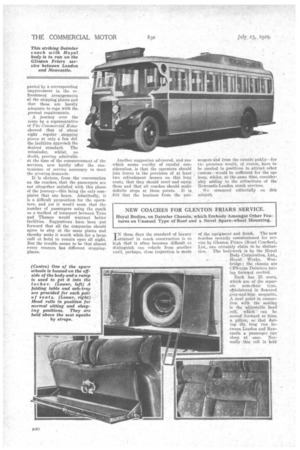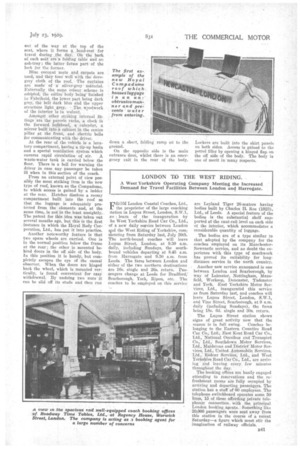PHASES OF PASSENGER• TRAVEL
Page 64

Page 65

Page 66

Page 67

If you've noticed an error in this article please click here to report it so we can fix it.
Notes on Every Aspect of Coach and Bus Development.
OUT TO BREAK RECORDS.
Improved Rolling Stock and a Better Understanding Amongst Operators Augur Well for Blackpool's Coach Season.
BLACKPOOL coach oWners are this year out to break all records, and there is every probability that they will succeed. During the past year or two the local fleet of about 250 coaches has been completely overhauled and modernized, with the result that to-day Blackpool makes the claim of having the finest fleet of coaches operated at the lowest fares in the country. During the winter months daily service to London, the Midlands and the northern cities have been established, sometimes in co-operation with Manchester coach
proprietors. Services are now being operated all the year round to Manchester, Liverpool and intervening towns, some of which are duplicated, and even triplicated, on busy days.
It is estimated that close upon 1300,000 is sunk in Blackpool-owned motor coaches, to which sum of course, must be added approximately £250,000 for garages, stations, maintenance plant, etc. In the space of seven years the number of coaches operated from Blackpool has advanced from 156 (mostly open coaches fitted with solid tyres) to 260, nearly all of them saloons equipped in the most modern way.
We well remember the period when the common complaint of Blackpool coach owners was that the week-ends, when the visiting population of the town was in a state of change owing to the return of thousands of holiday-makers th their home towns, and the arrival of thousands of others commencing their holidays, it was almost impossible to get week-end traffic, even for the short afternoon and evening trips, costing about is. or 1s. 6d. All that has changed. Owners realize that there is not much scope for local pleasure trips during the week-end travelling, hustle, and consequently they transfer their vehicles to other Lancashire and Yorkshire towns and carry people to Black1)&01.
The Blackpool and District Motor
Coach Owners' Association numbers in its membership almost 100 per cent, of the local operators, and, following the success achieved last year in the estab-, lishment of uniform " high-season " fare schedules, it is satisfactory to learn that owners have decided this season to repeat the experiment. From Monday, July 15th, the following standard list of minimum return fares is in operation :— Morecambe, 4s.; Southport, 4s. 6d.; 'Windermere, is.; Keswick; 10s. ; Gretna Green, 14s.; London, • 25s. Until recently the following rates were accepted for these return journeys :----Morecambe,, 2s. ; Southport, 2s. 6d.; Windermere, Ss.; Keswick, Sc.; Gretna Green, 9s. 6d. and London, 11. Bearing in mind that the return journey to Gretna Green is one of 240 miles and the return journey to London about 470 miles, it will be seen that there is good justification for
the revision. On the London route there has been considerable competition, Carriage Co., Ltd., of Embankment Chambers, Charing Cross, London, W.C.2, is finding ample employment for its two Renault 20-seater saloon coaches.
The vehicles are operated from Bush House, Aldwych, London, which they leave daily at 7.45 a.m., and then proceed to Charing Cross Embankment, London, from which point they start at 8 a.m.; from Anglesey (Menai Bridge) they are operated at 8 am., and in each case the vehicles reach their destinations at 8 p.m.
The route is through some of the most picturesque parts of the country, including the towns of Bicester, Banbury, Stratford-on-Avon, Kidderminster, Bridgnorth, Shrewsbury, Llangollen, Corwen, Rettws-y-Coed and Bangor. Should passengers wish to reach any other part of the island of Anglesey, the company has an arrangement wit‘h. a local bus concern which enables the travellers to be conveyed at reasonable fares to Holyhead, Beaumaris, etc.
The coaches make three stops en route, an hour being permitted for lunch and half-an-hour for tea.
The single and return fares from London to Anglesey are 20s. and 37s. 6d. respectively, and those for the journey from London to Banbury are Ss. and 15s. respectively ; the ticket for the trip from London to Stratford-cmAvon costs Os., whilst the return rate iS 17s. ; for the .single journey from London to Shrewsbury 13s. isTeharged, and for the return journey 25s.; the single and return fares from Landon to
21Nappeal made by the Great Western Express Co., Ltd., of London, against the refusal by the -Cardiff Corporation of licences to ply for hire on the Cardiff section of its Cardiff-London service was heard at Cardiff on July 12th by.Mr. Percy Grey, on behalf of the Ministry of Transport.
The operating company contended that the adequacy of railway facilities should not be allowed to influence the decision of a licensing authority in regard to the granting of licences for road services. It stated that the provision "foe appeal to the Ministry of Transport bad been set up under the Roads Act, and there was no statutory or commonlaw foundation for taking railway facilities into account.
The appellant stated that it now appeared that the Cardiff Corporation had been influenced by the existence of railway facilities, and, in mentioning this, the company drew attention to the fact that coach operators were not informed-: why their I applications for licenkes weFe. -declined, .so, that Until the I:nearing of an aPpeal: actually took place the. appellant .was often -unaware
of the licensing authority's case. . .
The coaches in question have been operated from, the company's Westgate Street Garage in Cardiff, passengers entering the vehicles inside the garage. As far as Newport the coaches have run over a route operated by the Cardiff Corporation, but the company's minimum fare between Newport and Cardiff has been more than double that charged by the corporation and the company did not pick up or set down passengers between the two towns. •
Mr. Gerald Nowell, managing director of .the company, said that in March last the. serviee was increased to three coaches daily in each direction and that in the month of June--3,503 passengers were carried, 800 travelling by night.
Mr. A. Wilson, Chief. Constable of Cardiff, considered -that. • each bus alioulifeart.y a coin:Nell:1i. . r
in Queen Street, Cardiff, he said the company was agreeable to commence journeys from Eitzalan Place, Newport Grove. He expressed willingness to have all drivers instructed in first-aid administration and to carry first-aid equipment on all coaches.
On the 'saune occasion Mr. Remy Grey heard the appeal of the South Monmouthshire Motor Co., Ltd., against a similar refusal by the Cardiff Corporation of licences for a CardiffLondon service. The contentions of this company were in many respects similar to those of the Great Western Express Co., Ltd.
A decision in the two cases will shortly be announced by the Ministry. ponied by a corresponding improvement in, the refreshment arrangements at the stopping places and that these are hardly adequate to cope with the present requirements.
A journey over the route by a representative of The Conmercial Motor showed that of about eight regular stopping places at only a few did the facilities approach the desired standard. The remainder, whilst, no doubt, proving admirable at the time .of the commencement of the services, now hardly offer the convenience of service necessary to meet the growing demands.
It is obvious, from, the conversation on the coaches, that the passengers are not altogether satisfied with this phase of the journey—this being the only complaint that one hears. Admittedly, it is a difficult proposition for the operators,. and yet it wouli seem that •the number of passengers using the coo& as a method of transport between Tyne and Thames wonid warrant better facilities. Suggestions have been put forward that all the companies should agree to stop at the same places and thereby make it worth while for a large cafe or hotel to remain open all night. But the trouble seems to be that almost every concern litas different stoppingplaces. Another suggestion advanced, and one which seems worthy of careful consideration, is that the operators should join forces in the provision of at least two refreshment houses on this long route, that they should erect and equip them and that all roaches should make definite stops at those points. It is ,felt that the business from the pas seugers and from the outside pubEt—for tho premises would, of course, have to be erected in positions to attract other custom--would be sufficient for the upkeep; whilst, at the same time, considerably adding to the attractions of the Newcastle-London coach services.
We comment editorially on this subject. out of the way at the top of the seat, where it forms a head-rest for travel during the day. On the back of each salt' are 'a folding table and on ash-tray;. the latter forms parr of the lock for the former.
Blue coconut :mats and carpets are used, and they tonewell with the dovegrey cloth of the roof. The curtains are madeof a. silver:grey material. Externally the same •coleur scheme is adeptedi the entire ' bad' being finished in liabrikoid, the lower part being dark grey, the belt dark blue and the upper structure light .grey. • The woodwork of the interior 'm in walnut.
Amongst other striking internal fittings are the parcels racks, a clock in the forward bulkhead, a calendar, a mirror built into a cabinet in the centre Pillar at the front, and electric bells for conimunicating with the driver.
At the rear of the vehicle is a lavatory compartment, having a tip-up basin and a special ventilation system which ensures rapid circulation of air. A waste-water tank is carried below the floor. There is a bell for warning the driver in case any passenger be taken ill when in this section of the coach.
From an external point of view possibly the most striking item is the new type of roof, known as the Compadome, to which access is gained by a ladder at the rear. Hatches disclose a roomy compartment built into the roof so that the luggage is adequately protected from the elements and, at the same time, is not in the least unsightly. The patent for this idea was taken out several months ago, but this is the first instance In which the Royal Body Corporation, Ltd., has put it into practice.
Another noteworthy feature is that two spare wheels are carried. One is in the normal position below the frame at the rear ; the other is mounted behind doors in the off side of the body. In this position it is handy, but completely escapes the eye of the casual observer. When the doors are hinged back the wheel, which is mounted vertically, is found convenient for easy withdrawal. By undoing two nuts it can be slid off its studs and then run EIROM London Coastal Coaches, Ltd.. 1.2 the proprietor of the large coaching ;tatMn in Lupus Street, London, S.W.1, we learn of the inauguration by die West Yorkshire Road Car Co., Ltd., of a new daily serviee between London %rid the West Riding of' Yorkshire, comnlencing from Saturday last, July 20th. The north-bound coaches will leave Lupus Street, London, at 9.30 a.m. daily, including Sundays, the southbound vehicles departing at 8.45 a.m. from Harrogate and 9.30 a.m. from Leeds. The fares between London and either of the two northern destinations are 16s. single and 26s. return. passengers change at Leeds for Bradford,' Scarborough, York, Ripon, etc. The coaches to be employed on this service
are Leyland Tiger 26-seaters having bodies built by Charles H. Roe (1923), Ltd, of Leeds. A special feature of the bodies is the substantial shelf supported at the cant-rail level on each side of the interior, which accommodates a considerable quantity of luggage.
The bodies are of a type similar to that adopted by the company for the coaches employed on its ManchesterNewcastle service, and no doubt the experience with this type of coachwork has proved its suitability for longdistance service in the north country.
Another new service announced is one between London and Scarborough, by way of Leicester, Nottingham, Mansfield, Worksop, Doncaster, Tadeaster and York. East Yorkshire Motor Services, Ltd., inaugurated this service as from Saturday last, and coaches will leave Lupus Street, London, S.W.1, and Vine Street, Scarborough, at 9 a.m. daily (including Sundays), the fares being 18s. 6d. single and 30s. return.
The Lupus Street station shows signs of great activity now that the
season is in full swing. Coaches belonging to the Eastern Counties Road Car Co., Ltd., East Kent Road Car Co., Ltd.; National Omnibus and Transphrt Co., Ltd., Southdown Motor Services, Ltd., Maidstone and ,Distrier Motor Services, Ltd., United Automobile Services, Ltd.. Redcar Services, Ltd„ and West Ydrkshire Road Car Co., Ltd., are arriving atal leaving every few minutes throughout the day.
The booking offices are busily engaged attending to reservations and the refreshment rooms are fully occupied by arriving and departing passengers. The Station hah a staff of 60 employees. The telephone switchboard operates some 50 lines, 15 of these affording private telephonic Connection with the principal London booking agents. Something like 20,000 passengers were sent away from this station in the course of a recent Saturday—afigure which must stir the iniagination of railway officials.




















































































































